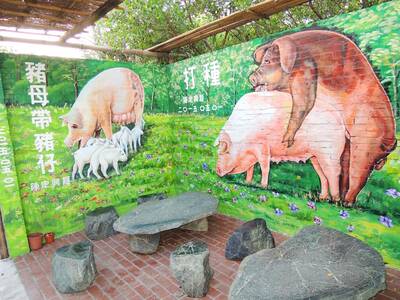As the first animated work to adapt the classic Chinese love story of the same name, Butterfly Lovers: Leon and Jo (
It is an acceptable film. As a tragedy, it makes you cry. And as a story about Chinese culture and sentiment, it has also got the right feel. There are even two Mando-pop divas singing love songs in the movie, adding more touching sentiment.
However, it is not hard to find some obvious problems.

PHOTO COURTESY OF CMP
The story of Liang Shan-po (
In order to pursue her studies, Jo dresses as a boy when she meets Leon on the way to school. They quickly become best friends, carrying on a flirtation that hints at Jo's sex. When Jo is revealed as a woman, Leon immediately falls in love with her, only to find out she is about to married, forced by her father to couple with the son from a rich family.
Those familiar with Disney animations will find the animation work in this movie a little raw and the movement of the characters a bit stiff.
Those seeking a Pixar-standard of 3D animation may be a little disappointed. Fortunately, the music and the dubbing has added some class to the movie.
Both Rene Liu (
The music for the movie adapts the world-famous Butterfly Lovers Violin Concerto, by Chinese composers Chen Gang (
The flowing Chinese-style violins represent the "falling in love" segment; and the high and rapid tones represent the
"refusing to marry part."
At the end, the powerful sounds of gongs represents the climax of the tragedy -- as the protagonists metamorphose into butterflies.
The picture also improves when the pair are ready to sacrifice their love. The colors are glowing and their use is wilder, making for a more imaginative section of the movie.

May 6 to May 12 Those who follow the Chinese-language news may have noticed the usage of the term zhuge (豬哥, literally ‘pig brother,’ a male pig raised for breeding purposes) in reports concerning the ongoing #Metoo scandal in the entertainment industry. The term’s modern connotations can range from womanizer or lecher to sexual predator, but it once referred to an important rural trade. Until the 1970s, it was a common sight to see a breeder herding a single “zhuge” down a rustic path with a bamboo whip, often traveling large distances over rugged terrain to service local families. Not only

Ahead of incoming president William Lai’s (賴清德) inauguration on May 20 there appear to be signs that he is signaling to the Chinese Communist Party (CCP) and that the Chinese side is also signaling to the Taiwan side. This raises a lot of questions, including what is the CCP up to, who are they signaling to, what are they signaling, how with the various actors in Taiwan respond and where this could ultimately go. In the last column, published on May 2, we examined the curious case of Democratic Progressive Party (DPP) heavyweight Tseng Wen-tsan (鄭文燦) — currently vice premier

The last time Mrs Hsieh came to Cihu Park in Taoyuan was almost 50 years ago, on a school trip to the grave of Taiwan’s recently deceased dictator. Busloads of children were brought in to pay their respects to Chiang Kai-shek (蔣中正), known as Generalissimo, who had died at 87, after decades ruling Taiwan under brutal martial law. “There were a lot of buses, and there was a long queue,” Hsieh recalled. “It was a school rule. We had to bow, and then we went home.” Chiang’s body is still there, under guard in a mausoleum at the end of a path

Last week the Directorate-General of Budget, Accounting and Statistics (DGBAS) released a set of very strange numbers on Taiwan’s wealth distribution. Duly quoted in the Taipei Times, the report said that “The Gini coefficient for Taiwanese households… was 0.606 at the end of 2021, lower than Australia’s 0.611, the UK’s 0.620, Japan’s 0.678, France’s 0.676 and Germany’s 0.727, the agency said in a report.” The Gini coefficient is a measure of relative inequality, usually of wealth or income, though it can be used to evaluate other forms of inequality. However, for most nations it is a number from .25 to .50